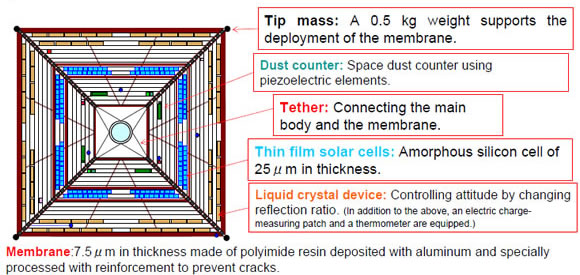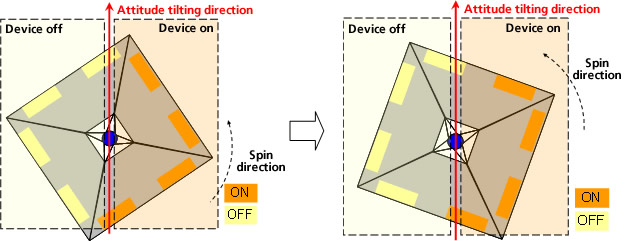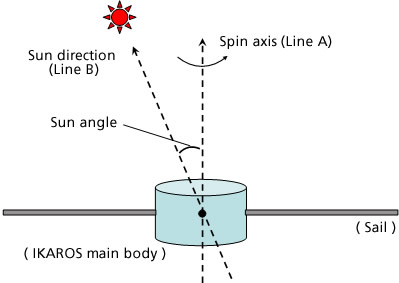Small Solar Power Sail Demonstrator 'IKAROS'
Successful Attitude Control by Liquid Crystal Device
Japan Aerospace Exploration Agency (JAXA)
The Japan Aerospace Exploration Agency (JAXA) performed an attitude control experiment (*1) of the solar sail of the Small Solar Power Sail Demonstrator "IKAROS," after its deployment, using an attitude control device, or the liquid crystal device, on July 13, 2010 (Japan Standard Time, the following dates and time are JST, unless otherwise noted. ) We have since confirmed that the attitude control performance was successfully accomplished as planned through post-experiment data verification and analysis. The IKAROS was launched from the Tanegahima Space Center on May 21, 2010.
The liquid crystal device is a thin-film instrument to change the surface reflection characteristics of sunlight by turning on and off the power of the device. It is an engineering test device to control attitude using only sunlight pressure without any additional propellant.
Two kinds of technologies are extremely important for a spin solar sail, like the IKAROS's sail: one is technology to generate small attitude control torque (*2) constantly without causing oscillation on the large flexible sail, and the other is technology to control the direction (attitude) of large angular momentum generated by the spinning membrane without consuming propellant. The attitude control method using sunlight pressure is one of the most feasible methods for satisfying the above two technological requirements, and JAXA has been a global leader in developing this original method.
JAXA will continue the attitude control experiment by the IKAROS to evaluate the details of the attitude control performance while continuing to conduct research on attitude control technology using sunlight pressure as a technology that enables navigation for longer in time and further in distance by a solar sail.
*1 The IKAROS usually uses its onboard thrusters attached to its main body, not the liquid crystal device, for attitude control during normal operations.
*2 Torque is a moment of force to rotate an object about an axis or pivot. For the attitude control experiment using the liquid crystal device this time, the attitude control torque was minimal as sunlight pressure was used for attitude control, thus, by generating torque constantly, it was possible to control attitude without causing vibration on the membrane.

Image of the attitude control by liquid crystal device

Image of controlling the device by turning it on/off synchronized in a spin cycle

As you can see in the above image, there are eight blocks on the membrane to turn the device on and off by synchronizing with the spin cycle to generate attitude control torque to a desired direction.
Evaluation result of attitude control performance by liquid crystal device

The above chart shows the evaluation result of the attitude control experiment by the liquid crystal device between 7:35 a.m. on July 13 and 6:25 a.m. on July 14, 2010 (Universal Time) based on sun angle (*3.) As you can see, the solar angle was gradually increasing without control, while it was decreasing when the liquid crystal device was used to control the attitude toward the sun direction.
We were able to confirm that we have achieved the expected control performance of more than 90 % of the expected attitude control angle after the initial evaluation by incorporating various factors of the IKAROS at the time of the experiment such as the spin rate, distance to the sun and sun angle.
We will continue to evaluate the experiment results more precisely with more details by further integrating the influence of a tilt of the liquid crystal device against the spin axis due to slight distortion of the sail, and more accurate analysis results of the radius after extending the sail in orbit.
*3 Sun angle is an angle made by the following Line A and B.
Line A: IKAROS's spin axis
Line B: a line connecting the IKAROS and the sun

|
|